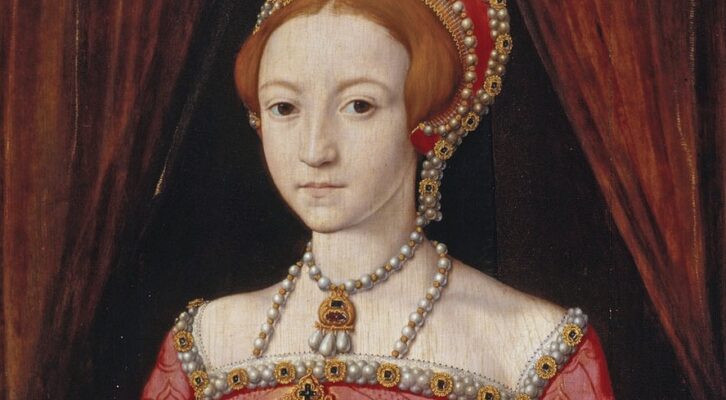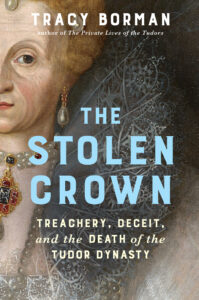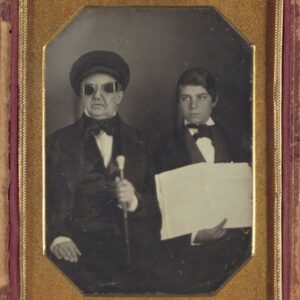
The Succession Crisis of Queen Elizabeth I
Tracy Borman on the Altered Manuscript Depicting the Naming of Queen Elizabeth’s Heir
On October 10, 1562, Queen Elizabeth I was staying at Hampton Court when she was taken suddenly and dangerously ill. “She is in great danger,” the Spanish ambassador Bishop Álvaro de la Quadra reported six days later. “If the Queen should die it will be very soon, within a few days at latest.” Nobody expected her to survive. “Last night the palace people were all mourning for her as if she were already dead,” he wrote in another hurried dispatch the following day, adding that Elizabeth was “almost gone.”
The Queen was twenty-nine years old and had reigned for just shy of four years. Her three immediate predecessors had only reigned for eleven years between them. Now it seemed the ill health that dogged the Tudors would claim another victim. Even if Elizabeth recovered, the odds were stacked against her. She was technically illegitimate, her mother Anne Boleyn’s marriage to Henry VIII having been annulled shortly before her execution at the Tower of London in 1536. Added to that, in the eyes of Roman Catholic Europe—and many of her own subjects—the new Queen was a heretic.
Worse still, Elizabeth was unmarried so had no child to inherit the throne if she died. “In the end this shall be for me sufficient: that a marble stone shall declare that a queen, having reigned such a time, lived and died a virgin,” she had told the first Parliament of her reign in February 1559. As her life hung in the balance at Hampton Court, there was an urgent meeting of her council at the palace to decide who should succeed her if she died. “Now all the talk is who is to be her successor,” the Spanish ambassador reported.
As one contemporary shrewdly observed: “This crown is not like to fall to the ground for want of heads that claim to wear it.”
The two main contenders were Elizabeth’s closest blood relative Mary, Queen of Scots and Katherine Grey, sister of the ill-fated Lady Jane. The latter’s supporters pointed to the fact that the Scottish queen was a Catholic and was technically disqualified by the terms of Henry VIII’s will, which stated very clearly that his Stuart relatives should never inherit the crown of England. Katherine was a Protestant and the legal heir according to Henry’s will, as well as the “Device” for the succession drafted by his son Edward VI on his deathbed in 1553.
As the crisis reached fever pitch, on October 23 news arrived from the Queen’s privy chamber. Against all the odds, the queen survived. But the succession crisis that her sudden and dangerous illness had brought to the fore would dominate the rest of her long reign. Elizabeth’s determination not to settle the succession gave rise to fierce rivalry between the claimants to the English throne, among them Mary, Queen of Scots and her son James VI; James’s cousin Arbella Stuart; Lady Katherine Grey and her descendants; and Henry Hastings, Earl of Huntingdon. As one contemporary shrewdly observed: “This crown is not like to fall to the ground for want of heads that claim to wear it.”
As Elizabeth’s long reign wore on, so most of the rival claimants fell by the wayside, either through natural death, disinheritance or execution. In the race for her throne, it was less a case of “who dares wins” than of “survival of the fittest.”
By 1603, James VI had apparently emerged as the favorite. His legitimacy, lineage, gender and Protestant religion gave him the edge over his rivals, even if there were still doubts over the legality of his claim. The fact that the King of Scots had two sons also worked in his favor: if he should succeed, the future of the monarchy seemed secure. In ever greater numbers, Elizabeth’s subjects flocked north to ingratiate themselves with the Queen’s likely successor. According to her earliest biographer, William Camden: “They adored him as the sun rising, and neglected her as now ready to set.”
But detailed analysis of Camden’s original manuscript published by the British Library in 2023 has revealed that key passages were pasted over and rewritten after Elizabeth’s death to make them more favorable to her successor.
It was also Camden who, in his monumental work Annales: The True and Royall History of the Famous Empresse Elizabeth (first published in 1615) claimed that almost with her last breath, Elizabeth named James VI as her heir. According to his account, as the dying Queen’s anxious ministers clustered around her bed at Richmond Palace in March 1603, they urged her one last time to settle the succession. Rousing herself from her stupor, she declared that James should inherit her crown, insisting: “I’ll have none but him.” She died shortly afterwards and the throne of England passed peacefully to the King of Scots.
But detailed analysis of Camden’s original manuscript published by the British Library in 2023 has revealed that key passages were pasted over and rewritten after Elizabeth’s death to make them more favorable to her successor. Thanks to advances in enhanced imaging, concealed lines could be read for the first time. They suggest that Camden was so concerned not to offend the new king that he rewrote key sections of his manuscript, pasting new pages over his original text.
Among the findings are that Elizabeth’s last-gasp naming of James as her heir was a work of fiction, designed to make his accession appear more predetermined than it had been. The real story of the Elizabethan succession was altogether darker and more turbulent than Camden’s fiction. His original, undoctored manuscript even suggests that James might have plotted to have Elizabeth assassinated.
This staggering new discovery changes everything we thought we knew about the transition from the Tudors to the Stuarts, which for more than 400 years has been traditionally presented as both rightful and peaceful. It inspired my research for The Stolen Crown, which reveals the real story behind the fiction created by Camden and considers who might have been England’s new King—or Queen—if James had not seized the throne by underhand means.
The lie that began James’s reign would have far-reaching consequences. Ignoring the advice that Elizabeth had drip-fed him for more than twenty years, he stood firmly by the Stuart belief in the divine right of kings, which in his view gave him the right to ride roughshod over the wishes of his people. His son and successor Charles I took this to even greater extremes and dissolved Parliament whenever it refused to carry out his will.
By 1642, he had pushed the supremacy of the royal will too far on both sides of the border. The kingdom was plunged into a series of bitterly fought civil wars that culminated in Charles’s execution in January 1649. In the space of a generation, the crown that had glittered so brightly on Elizabeth’s head had been consigned to the dust.
__________________________________

Tracy Borman’s new book is The Stolen Crown: Treachery, Deceit and the Death of the Tudor Dynasty (Grove Atlantic, November 4, 2025).
Tracy Borman
Tracy Borman is England’s joint Chief Curator of Historic Royal Palaces and Chief Executive of the Heritage Education Trust. She is the author of many highly acclaimed books, including Crown & Sceptre, Henry VIII and the Men Who Made Him, The Private Lives of the Tudors, Thomas Cromwell, Queen of the Conqueror, Elizabeth’s Women, Witches, as well as the trilogy of novels The King’s Witch, The Devil’s Slave, and The Fallen Angel. Borman is also a regular broadcaster and accomplished public speaker.



















